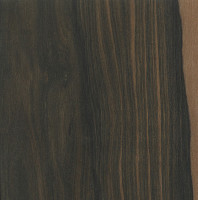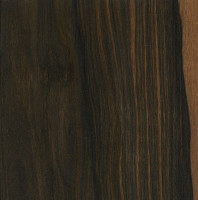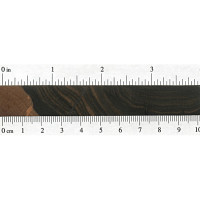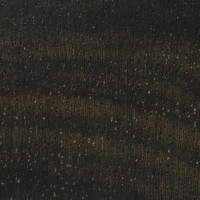 |
Common Name(s): Mun Ebony, Vietnamese Ebony Scientific Name: Diospyros mun Distribution: Laos and Vietnam Tree Size: Reported to be a small, slow-growing tree Average Dried Weight: 67 lbs/ft3 (1,065 kg/m3) Specific Gravity (Basic, 12% MC): .82, 1.07 Janka Hardness: 3,000 lbf (13,350 N) Modulus of Rupture: No data available Elastic Modulus: No data available Crushing Strength: No data available Shrinkage: No data available |
Color/Appearance: Heartwood is medium brown, sometimes with a reddish hue, commonly with dark brown to black streaks throughout. Clearly demarcated sapwood is a pale yellow to white.
Grain/Texture: Grain is straight, with a very fine uniform texture and a high natural luster.
Endgrain: Diffuse-porous; solitary and radial multiples; medium pores in no specific arrangement, moderately numerous to numerous; parenchyma diffuse-in-aggregates; narrow rays, spacing close.
Rot Resistance: No data available.
Workability: Difficult to work due to its high density. As with other ebonies, Mun Ebony may present difficulties in gluing. Turns and finishes superbly.
Odor: No characteristic odor.
Allergies/Toxicity: Although severe reactions are quite uncommon, Ebony in the Diospyros genus has been reported as a sensitizer. Usually most common reactions simply include eye, skin, and respiratory irritation. See the articles Wood Allergies and Toxicity and Wood Dust Safety for more information.
Pricing/Availability: Because of exploitation and drastic population reductions, export of Mun Ebony is currently banned. Prices for the wood are likely to be very high, and from dubious sources.
Sustainability: This wood species is not listed in the CITES Appendices, but is on the IUCN Red List. It is listed as critically endangered due to a population reduction of over 80% in the past three generations, caused by a decline in its natural range, and exploitation.
Common Uses: Inlay, carvings, veneer, and turned objects.
Comments: No data available.
 |
 |
 |
 |





A turned bowl from mun ebony
Hey I just bought a kind of wood that is pitch black like gaboon ebony, but its name is “Diospyros eriantha”, or the Vietnamese call it ” black persimmon wood”. Do you think it should be called an “ebony” wood?
I will upload the images of the wood if you need.
In my opinion, if it’s pitch black, and in the Diospyros genus, it’s 100% valid to refer to it as ebony.
People should stop cutting it down, or it will be mun ebony no more!
I wanna punish the people who caused it to be critically endangered.
sad thing is it is illegal logging and people using it as fuel that are the main cause not people who use it for buildng furniture ,instruments etc .
And the people cutting it down for livestock and animal feed farmland